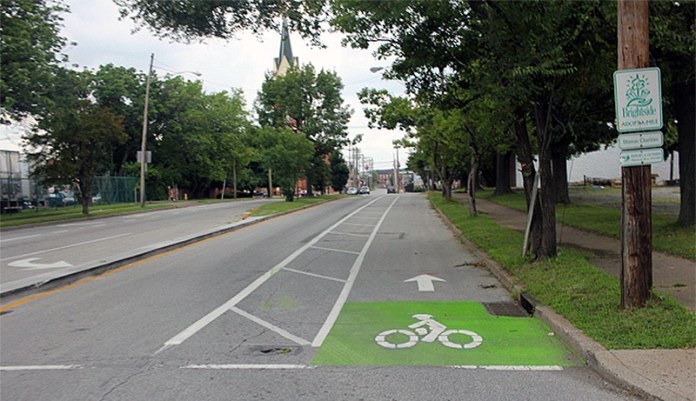If you look past the giant new highway interchange, there's encouraging transportation news coming out of Louisville.
The city is making an effort to build out its bike network, adding a number of buffered bike lanes and beginning a network of low-stress "Neighborways" along residential streets.
It's a start, says Branden Klayko, who's writing again at Broken Sidewalk after battling leukemia much of the past year (welcome back Branden!). But peer cities like Indianapolis and Pittsburgh are doing more to make cycling an appealing way to get around. Klayko lays out what Louisville needs to do to catch up:
Louisville has made some serious progress in building up its bike network, but there’s a lot of work still to be done. As Bicycling magazine pointed out, the city has upgraded its infrastructure but lags behind other cities like Indianapolis in terms of high quality design for protected bike lanes. Louisville’s successful Neighborways is promising, but today it’s little more than a collection of sharrows. More substantial design including signage and traffic diverters should be installed to make the system easier and safer to use. To achieve these infrastructure goals, the city’s agency covering bicycling, Bike Louisville, should see its budget increase annually, not decrease. And the city’s minuscule rate of bike commuting could easily be improved.
There are good things on the horizon as well. Louisville continues to build out its bike network with more innovative designs than we’ve seen in the past and a new bike share system is set to launch later this year. Bicycling for Louisville recently listed the city’s biggest bike wins of 2016, which included new protected bike lanes on 12th and 13th streets, ongoing planning for an extended Beargrass Creek Trail, and expansion of the Neighborways program. This year, the group is advocating for protected bike lanes on Castlewood and Barret avenues and road diets along West Jefferson Street in Russell and along Oak and Winter streets in the Highlands.
These infrastructure improvements are also critical for Louisville to reduce its dependency on automobiles. Research has shown that the better a city’s bike network, the more people bike. Louisville’s network is beginning to reach a critical capacity with easy to use bike lanes and Neighborways where biking becomes a very comfortable and safe option for for a larger percentage of the population. Options like well-designed protected bike lanes can help encourage people who haven’t commuted by bike to give it a try. And with only 0.4 percent of the population saddling up to go to work, there’s plenty of room to attract new audiences.
More recommended reading today: Green City Blue Lake reports that Cleveland's transit-oriented development projects are generating impressive results but remain too rare. Streets.mn considers how bicycling advocates can better support parents who bike with their kids. And Smart Growth America reports on what some Florida planning officials are learning about how to make the state's notoriously dangerous roads safer for walking and biking.





